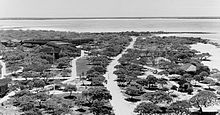
Wake Island is a coral atoll in the Micronesia subregion of the northwestern Pacific Ocean. The atoll is composed of three islets and a reef surrounding a lagoon. The nearest inhabited island is Utirik Atoll in the Marshall Islands, located 592 miles to the southeast. The United States administers Wake Island as an unorganized and unincorporated territory, and it is one of the nine insular areas that comprise the United States Minor Outlying Islands. The Marshall Islands also claim Wake Island.

The Pearl and Hermes Atoll, also known as Pearl and Hermes Reef, is part of the Northwestern Hawaiian Islands, a group of small islands and atolls that form the farthest northwest portion of the Hawaiian island chain. The atoll consists of a variable number of flat and sandy islets, typically between five and seven. More were noted in historical sources but have since been lost to erosion and rising sea levels.
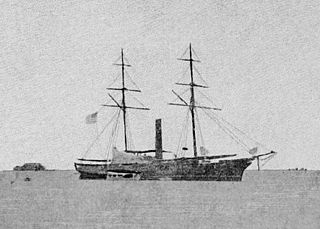
The first USS Saginaw was a sidewheel sloop-of-war in the United States Navy during the American Civil War. The ship was in operation throughout the 1860s, but in 1870 wrecked on what is now known as Kure Atoll, a Pacific island. The event produced several books and one of the surviving boats from the ship is in a museum.
Sir Charles Hardy Islands is in the reef of the same name adjacent to Pollard Channel & Blackwood Channel about 40 km east of Cape Grenville off Cape York Peninsula.

The Diosa del Mar was a wooden schooner that sank off of the coast of Catalina Island at 2:25 pm on July 30, 1990.
Tryall was a British East India Company-owned East Indiaman launched in 1621. She was under the command of John Brooke when she was wrecked on the Tryal Rocks off the north-west coast of Western Australia in 1622. Her crew were the first Englishmen to sight or land on Australia. The wreck is Australia's oldest known shipwreck.
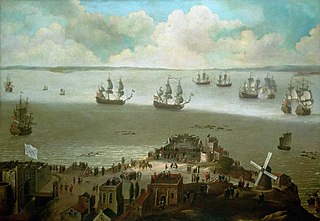
HMS Tyger, often spelled Tiger, was a 38-gun fourth rate frigate of the Royal Navy, built by Peter Pett II at Woolwich and launched in 1647. The term 'frigate' during the period of this ship referred to a method of construction, rather than a role which did not develop until the following century. Tyger was the third ship of the Royal Navy to bear the name, and by successive rebuildings she served for almost a century until she was wrecked in the Dry Tortugas in 1742. The ship's crew was stranded on Garden Key for 56 days, fighting off Spanish attempts to capture them, and then spent another 56 days sailing in small boats 700 miles (1,100 km) to Port Royal, Jamaica. Remarkably, only five crew members died during this period: three killed by the Spanish, and two others of natural causes. Six crewmen were captured and imprisoned by the Spanish. The captain and three of his lieutenants were court-martialed over the wreck and subsequent events.

Elizabeth Reef, located at 29°57′25″S159°4′32″E, is a coral reef in the Coral Sea. The reef is separated by a deep oceanic pass, some 47 km wide, from nearby Middleton Reef, both of which are part of the underwater plateau known as the Lord Howe Rise. It is around 150 km from Lord Howe Island and 600 km from the New South Wales coast of Australia. The Environment, Sport and Territories Legislation Amendment Act 1997 included Elizabeth Reef in Australia's Coral Sea Islands Territory.
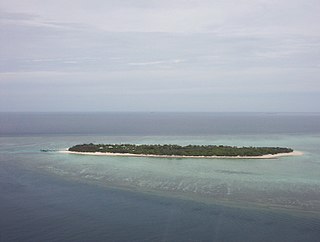
The islands and reefs of the Capricorn and Bunker Group are situated astride the Tropic of Capricorn at the southern end of the Great Barrier Reef, approximately 80 kilometres east of Gladstone, which is situated on the central coast of the Gladstone Region, Queensland, Australia.
Netherby was a full-rigged sailing ship of the Black Ball Line that ran aground and sank off the coast of King Island—an island in Bass Strait between Tasmania and the Australian mainland—on 14 July 1866 while sailing from London to Brisbane.
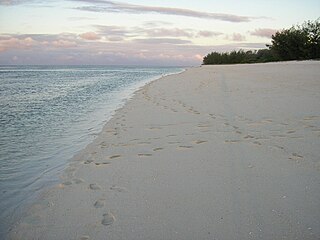
Masthead Island is a coral cay located in the southern Great Barrier Reef, 60 kilometres northeast of Gladstone, Queensland. The island is a protected area and forms part of Capricornia Cays National Park. Masthead Island is one of the most undisturbed cays in the national park because human and feral animal impacts have been rare. The cay covers an area of 0.45 square kilometres (0.17 sq mi) and is surrounded by a coral reef that is partially exposed at low-tide. It is part of the Capricornia Cays Important Bird Area.
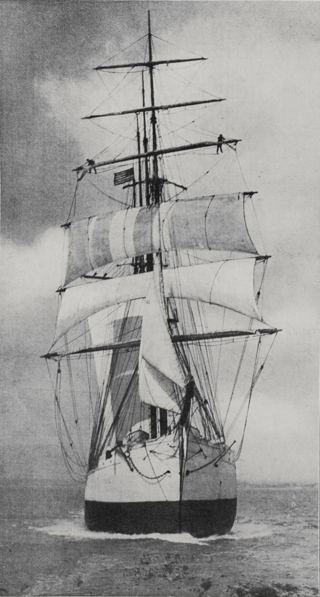
Amaranth was a four-masted barquentine built by Matthew Turner of Benicia, California in 1901. Amaranth sailed in the China trade between Puget Sound and Shanghai. She was wrecked on a guano island in the South Pacific in 1913 while carrying a load of coal.
Wreck of the Ten Sail is a historic shipwreck event that occurred off the East End of Grand Cayman on 8 February 1794. Ten ships that were part of a convoy on its way from Jamaica to the United States and Britain wrecked on the surrounding reef. While local residents braved the stormy waters and successfully rescued the ships' crews and passengers, eight people from the convoy died.

Colonist was a general cargo and passenger schooner built in 1861 at Dumbarton Scotland by Denny & Rankine. It spent nearly 30 years plying the Western Pacific-based out of Sydney. It wrecked and later re-floated on the remote Elizabeth Reef 550 km from New South Wales, as well as being involved in the gold rushes. Its master was murdered before it was finally involved in a collision in Sydney Harbour, in which it was sunk.

Carthaginian II was a steel-hulled brig outfitted as a whaler, which served as a symbol of that industry in the harbor of the former whaling town Lahaina on the Hawaiian island of Maui. She replaced the original Carthaginian, a schooner converted into a barque to resemble a period whaler, which had initiated the role of museum ship there in 1967.

Hermes was built in Quebec in 1811. She traded widely before she made two voyages as a whaler to the British Southern Whale Fishery. She was wrecked in 1822 during the second voyage.
